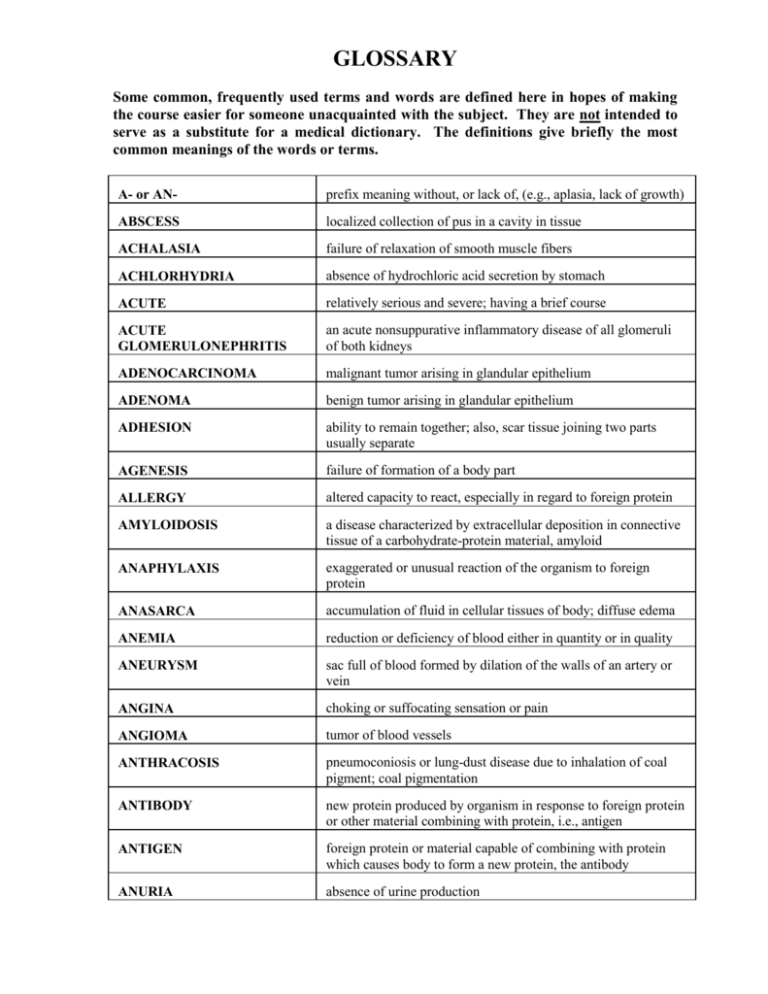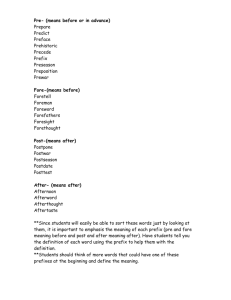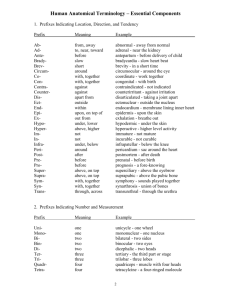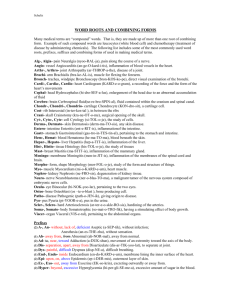glossary - Pathology
advertisement

GLOSSARY Some common, frequently used terms and words are defined here in hopes of making the course easier for someone unacquainted with the subject. They are not intended to serve as a substitute for a medical dictionary. The definitions give briefly the most common meanings of the words or terms. A- or AN- prefix meaning without, or lack of, (e.g., aplasia, lack of growth) ABSCESS localized collection of pus in a cavity in tissue ACHALASIA failure of relaxation of smooth muscle fibers ACHLORHYDRIA absence of hydrochloric acid secretion by stomach ACUTE relatively serious and severe; having a brief course ACUTE GLOMERULONEPHRITIS an acute nonsuppurative inflammatory disease of all glomeruli of both kidneys ADENOCARCINOMA malignant tumor arising in glandular epithelium ADENOMA benign tumor arising in glandular epithelium ADHESION ability to remain together; also, scar tissue joining two parts usually separate AGENESIS failure of formation of a body part ALLERGY altered capacity to react, especially in regard to foreign protein AMYLOIDOSIS a disease characterized by extracellular deposition in connective tissue of a carbohydrate-protein material, amyloid ANAPHYLAXIS exaggerated or unusual reaction of the organism to foreign protein ANASARCA accumulation of fluid in cellular tissues of body; diffuse edema ANEMIA reduction or deficiency of blood either in quantity or in quality ANEURYSM sac full of blood formed by dilation of the walls of an artery or vein ANGINA choking or suffocating sensation or pain ANGIOMA tumor of blood vessels ANTHRACOSIS pneumoconiosis or lung-dust disease due to inhalation of coal pigment; coal pigmentation ANTIBODY new protein produced by organism in response to foreign protein or other material combining with protein, i.e., antigen ANTIGEN foreign protein or material capable of combining with protein which causes body to form a new protein, the antibody ANURIA absence of urine production ARGYRIA pigmentation due to silver salt ARTERIOSCLEROSIS group of arterial diseases characterized by thickening of the vessels, frequently with hardening and/or calcification ARTHRITIS inflammation of a joint ASCHOFF BODY characteristic myocardial connective tissue change in rheumatic fever, cellular collection of mononuclear and giant cells around focus of fibrinoid necrosis ASCITES accumulation of fluid in peritoneal cavity ASPHYXIA suffocation; anoxia with increase of carbon dioxide ATELECTASIS incomplete expansion, especially of the lungs ATHEROMA lesion produced in intima of arteries with focal accumulation of lipids, complex carbohydrates, proteins, blood and blood products, fibrous tissue and calcium deposits and associated with changes in media ATRESIA absence or closure of a normal body opening ATROPHY decrease in size of cell, tissue, organ, part of or the whole body AUTO prefix relating to self or to same individuals; e.g., autograph, transplantation of tissue from one part to another of the same animal AUTOLYSIS literally self-lysis, a series of changes following death of an organism BACTEREMIA presence of bacteria in the blood BENIGN not harmful, not malignant BRONCHIECTASIS chronic dilatation of bronchi BRONCHITIS inflammation of the bronchi CACHEXIA body-wasting plus anemia CALCIFICATION deposition of calcium from blood and other body fluids CALCULUS concretion occurring within organism, made up in whole or in part of mineral salts CAPUT MEDUSA distention of superficial veins of abdomen centering on umbilicus as collateral circulation in portal vein obstruction CARBUNCLE compound necrotizing inflammation of skin and subcutaneous tissues, usually due to staphylococcal infection CARCINOGEN cancer-producing substance or force CARCINOID argentaffin tumor, usually of intestinal tract CARCINOMA malignant epithelial tumor CARCINOMA IN SITU malignant epithelial cells within normal confines or limits in the body; preinvasive carcinoma CASEATION type of necrosis in which involved tissue resembles cheese grossly CEROID wax-like material found as crystals in disease states CHARCOT JOINT damage to joint following nerve injury, as in tabes dorsalis CHEMOTAXIS cellular phenomenon of moving toward or away from a certain material CHONDRO- prefix referring to cartilage CHOREA convulsive nervous movements, both involuntary and irregular CHRONIC tending to long course; opposite of acute CIRRHOSIS hardening, usually of liver CLONE strain of cells deriving from single cell COAGULATION process of changing into or being changed into a clot COMA depressed consciousness with absence of response to stimuli COMMUNICATION transfer of information COMPATIBLE capable of coexistence without injury CONTINUITY quality of duration, existence over a serial period of time CONTROL that which directs, checks or restrains COR PULMONALE pulmonary heart disease; disease of heart secondary to disease of lungs or their vessels CRESCENT epithelial proliferation in space of Bowman's capsule in subacute and chronic glomerulonephritis CRETIN one whose physical and mental development has been retarded or arrested due to thyroid deficiency CYANOSIS blueness of the skin, or other part of body, due to insufficient oxygen CYST sac containing usually a fluid or semisolid material CYSTITIS inflammation of the urinary bladder DE- prefix meaning away from DEFINITION statement of the precise nature of a thing or meaning of a word DEGENERATION retrogressive changes of cells short of necrosis DEVELOPMENT series of changes characteristic of organism, including existence over serial period of time, growth and acquisition of new properties DIABETES literally "passing through"; increased urine output: diabetes mellitus and insipidus DIAGNOSIS determination of the nature of a condition or disease or a hypothetical concept concerning this DIAPEDESIS passage of cells through capillary wall DIFFERENTIATION process in development during which final properties are acquired DISEASE literally lack of comfort; anything that limits life in its powers, duration or enjoyment DIVERTICULUM pouch or pocket leading off from a main cavity or tube DUST CELLS phagocytic cells of lung containing inhaled particles DYSENTERY inflammation of intestines, with blood and mucus in frequent bowel movements DYSPNEA difficult breathing DYSTROPHIC caused by faulty or deficient metabolism ECLAMPSIA convulsions occurring in last three months of pregnancy associated with placental, renal and hepatic lesions EDEMA accumulation of fluid in body or body part beyond normal amounts EMBOLUS formed material circulating in the blood stream during life and coming to rest, blocking a vessel EMPHYSEMA air in tissues causing swelling EMPYEMA pus in a tissue space, e.g., pleural cavity ENCEPHALITIS inflammation of brain EOSINOPHIL having an affinity for eosin; staining pink in H & E stain; e.g., eosinophil leukocyte EPIDEMIC disease affecting more than usual number of people in a community at one time EPITHELIOID CELL cell resembling epithelium usually deriving from macrophage or histiocyte EPIZOOTIC disease affecting more than usual number of animals in a group at one time ERYSIPELAS reddening and inflammation of skin, usually due to streptococci, associated with constitutional symptoms ETIOLOGY study of the cause of disease, or the cause of disease EXOPHTHALMOS unusual protrusion of the eyeball FAT NECROSIS death of fatty tissue, usually result of spill of pancreatic lipase, trauma, etc FECALITH intestinal concentration formed around or from feces FEEDBACK activity which contains within itself cessation or stoppage FEVER body temperature above normal, or (old) disease so characterized FIBRINOID tissue material resembling fibrin found especially in collagen disease FIBROID term for uterine fibroleiomyoma FISTULA deep ulcer often communicating with an internal organ FOAM CELLS cells with vacuolated cytoplasm, usually containing fat droplets in vacuoles FRACTURE break in a bone; occasionally of some other structure, e.g., liver or spleen FURUNCLE nodular staphylococcal inflammation of skin, often in relation to a hair follicle or sweat gland; the common boil massive death of tissue, e.g., of an extremity GANGRENE GIANT CELL multinucleated large cells; found frequently in inflammation in late stages around foreign materials as Langhans' giant cell GLYCOGEN complex neutral polysaccharide, the storage carbohydrate of animals GLYCOSURIA sugar in urine GOITER enlargement of thyroid gland GOUT disturbance of purine metabolism causing urate deposits in joints and cartilages and arthritis symptoms GRAFT a transplanted piece of tissue GRANULOMA nodules of inflammatory cells, principally GUMMA local lesion of tertiary syphilis with soft tumor-like formations, histiocytes HAMARTOMA tumor-like collection of excess tissue or abnormally situated tissue formed during development HEALING see Repair HEART-FAILURE CELLS hemosiderin-containing macrophages in lung or sputum, resulting from escape of blood into alveoli HEMATIN brown to black pigment in tissue resulting from hemoglobin breakdown but not giving Prussian blue reaction of hemosiderin HEMOCHROMATOSIS disorder of iron metabolism with excessive iron absorption; deposited iron produces cirrhosis of liver and pancreatic damage with diabetes mellitus HEMOFUSCIN brown pigment not containing iron found in liver with hemosiderin in hemochromatosis HEMOPHILIA familial disease appearing in males, transmitted by females, characterized by absence of specific globulin in blood and imperfect coagulation HEMORRHAGE loss of blood from a vessel; a bleeding HEMOSIDERIN iron-containing crystalline ferritin complex HEPATIC CIRRHOSIS liver disease characterized by degeneration and regeneration of liver cells and (replacement) fibrosis HERNIA protrusion of tissue through an opening HETEROGRAFT piece of tissue transplanted from one species to another HOMEOSTASIS quality of tending to uniformity or stability HOMOGRAFT piece of tissue transplanted from one animal to another of the same species HYALINE literally glassy; used to describe homogenous amorphous deposits and materials HYDRO- prefix denoting water, in excess HYDRONEPHROSIS dilatation of kidney by urine accumulation HYPER- prefix meaning excessive, above or beyond HYPERPLASIA increase in size of a part due to increase of number of units HYPERTROPHY increase in size of a part due to increase in cell size HYPO- prefix meaning below, inferior, lacking ICTERUS Jaundice IMMUNITY condition of being immune, i.e., security against a particular disease or poison INCLUSION BODY characteristic intracellular (nuclear or cytoplasmic) body found especially in cells affected by viruses INDIVIDUALITY specificity; quality of possessing separate identity INDUCED brought about by some means; not natural INFARCTION necrosis of tissue due to ischemia INFECTION presence of pathogenic organisms in body and their effects; entrance of pathogenic organisms into body INFILTRATION material in tissue not normally present INFLAMMATION local cellular and vascular reaction to injury INFORMATION set of facts concerning the state of a source INJURY harm or damage; produced disturbance of structure and/or function INTERSTITIAL in spaces of a tissue; relating to such spaces INTUSSUSCEPTION passage of one portion of intestine into a adjacent portion INVASION entrance of material into abnormal situation ISCHEMIA decreased blood supply to cells or tissues ISO-GRAFT piece of tissue transplanted from one animal to another genetically related animal -IT IS suffix meaning inflammation JAUNDICE yellow appearance of skin, mucosa and conjunctives, and all organs, due to excess bilirubin in serum or organs KAPPA PARTICLES rickettsia-like bodies in strain of paramecia injuring other paramecia of same strain which do not possess kappa particles KARYO- prefix relating to the nucleus KARYOLYSIS nuclear solution KARYORRHEXIS nuclear breakdown with residual granules KELOID skin tumor or mass specifically following wounding or injury KYPHOSIS hunchback; dorsal curvature of spine LANGHANS GIANT CELL multinucleated large cell formed in relation to foreign material or bodies LESION characteristic change in organism produced by disease LEUKEMIA malignant proliferation of white blood cells LEUKEMOID reaction resembling leukemia; extreme leukocytosis of normal cells LEUKOPENIA Reduction in number of circulating leukocytes LOBAR PNEUMONIA pneumococcal infection of one or more lobes of one or both lungs LOBULAR describing involvement of lobule, e.g., lobular pneumonia, not involving the whole lobe LUPUS Literally wolf; specific disease of skin with tissue destruction and sometimes systemic lesions of collagen LYMPHADENITIS Inflammation of lymph nodes LYMPHEDEMA edema due to lymphatic obstruction MALACIA softening of tissue in disease, as encephalomalacia, osteomalacia MALIGNANT dangerous, acting viciously, a threat to life MELANIN pigment granules, usually black, derived from indole and present in animals MELENA- The passage of dark, pitchy, and grumous stools stained with blood pigments or with altered blood. METAPLASIA Replacement of one type of cell in tissue by another METASTASIS Transfer of disease from one organ to another not directly connected to it MILIARY Resembling a millet seed; marked by multiple small lesions barely visible to the naked eye MIXED TUMOR Tumor or neoplasm made up of one or more than one cell or tissue type MUCOCELE accumulation of mucus with cyst formation, as in appendix MYXEDEMA disease due to thyroid deficiency characterized by deposition of excess ground substance in subcutaneous tissue and viscera NATURAL occurring spontaneously; not made, brought about or induced NECROSIS death of cells NEOPLASIA process of new growth or tumor formation NEURONOPHAGIA destruction of nerve cells by phagocytic action, as in acute anterior poliomyelitis, etc NEVUS new growth of skin, usually containing nerve elements; also congenital dilation of blood vessels in part of skin OBSOLESCENCE process of passing out of existence or of becoming obsolete OBSTRUCTION something that impedes or blocks a flow OLIGURIA decrease of urine volume -OMA suffix meaning tumor of ORGANIZATION quality of being made up of connected interdependent parts -OSIS suffix meaning process or condition PAPILLARY projecting from a surface PAPILLOMA epithelial tumor projecting from a surface PARA- prefix meaning behind, e.g., para-appendiceal PARALYSIS loss or decrease of ability to move PARASITE an organism that lives on or within another without itself contributing PARESIS slight or partial paralysis PATHOGEN disease-producing agent PATHOGENESIS development of a morbid condition or disease PATHOLOGY the biological discipline which studies disease (or studies life in its abnormal forms and activities) PELLAGRA literally rough skin; clinical syndrome due to deficiency of niacin (nicotinic acid) characterized by diarrhea, dermatitis and dementia PEPTIC related to digestion PERFORATION a piercing or making a hole, as in a viscus PERI- prefix signifying around, e.g., periarteritis, or inflammation around the artery PHAGOCYTE cell of the body that ingests particulate matter PHTHISIS a wasting away (or a part or of the body); vernacular for pulmonary tuberculosis PIGMENT any dye or paint; any natural or abnormal coloring matter of the body PNEUMONIA inflammation of lungs, usually with consolidation and systemic symptoms PNEUMONITIS localized inflammation of lungs POISON substance capable of interfering with metabolic processes of a cell or part of a cell, of a tissue, organ or organism POLY- prefix signifying many or multiple POLYCYTHEMIA excess of erythrocytes POLYP pedunculated or sessile growth arising from mucosa and extending into a cavity POLYPOID like a polyp; projecting from a surface PROCESS series of changes PROGNOSIS prediction of probable outcome and/or course of a disease PSEUDO- prefix signifying false or non-identity PURPURA condition with confluent small hemorrhages over body surfaces PUS liquid material containing broken-down leukocytes and cells, usually resulting from inflammation PYELONEPHRITIS inflammation of pelvis and interstitial tissues of the kidney PYEMIA septicemia with pus in blood and secondary sites of suppuration PYLEPHLEBITIS inflammation of portal vein PYO- prefix meaning pus PYREXIA fever, temperature above normal PYURIA pus in urine RADIATION (emission of) waves or rays of heat, light, x-ray, or other radioactive materials REGENERATION renewal of lost tissue or parts REPAIR restoration of continuity after injury RHEUMATIC relating to inflammation of joints, or rheumatism RIGOR rigidity or stiffness SARCOMA malignant tumor of connective tissue, e.g., fibrosarcoma SCAR remnants or residuum of the healing process SCLER- prefix meaning hard SEMINOMA epithelial tumor arising in testis SESSILE with broad base of attachment SHOCK severe depression of bodily activities caused by infection, hemorrhage, trauma, etc. SIGN any objective evidence of disease SIGNAL that which affects a receptor; information SINUS pathologically, a suppurating channel or fistula SLUDGE particles in suspension in viscid fluid; settling out equals sludging SPASM sudden violent involuntary constriction of muscles or sudden transitory constriction of a canal, passage or opening STEATORRHEA excess of fat in stools; fatty stools STENOSIS narrowing of a duct, canal or channel or a natural passage SUBACUTE less than completely acute, between acute and chronic SYMPTOM any functional evidence of a disease or of a patient's condition SYN- prefix meaning together, e.g., syndrome SYNDROME a set of symptoms that occur together TABES wasting or atrophy or a part, e.g., tabes dorsalis, or atrophy of dorsal spinal columns in late syphilis TELEOLOGY type of thinking emphasizing purpose interpretation of structure and function TEMPLATE pattern, mould or gauge determining configuration of structure TERATO- prefix signifying relation to abnormal or monstrous growth, e.g., teratoma THROMBUS clot formed in blood during life TOLERANCE accepted without reaction or without usual reaction TOPHUS collection of urates in tissues in gout TRANSFUSION exchange of fluid between two organisms; blood transfusion, lymph transfusion TRANSPLANT exchange of tissue between two organisms TRANSPORT circulation of movement of materials TRAUMA injury or wound TREMOR involuntary trembling or quivering TUBERCLE small nodule, usually related to or caused by M. tuberculosis TUMOR literally any swelling of a part; usually a neoplasm ULCER lack of continuity of a mucous or cutaneous surface UREMIA excess urea in blood; symptom complex of renal failure VARIX enlarged and dilated vessel, usually tortuous, usually in vein VESICLE small collection of fluid, e.g., sunburn vesicle VOLVULUS intestinal obstruction due to twisting of bowel WOUND HEALING restoration of continuity after wounding XANTHOMA literally yellow tumor; subcutaneous collection of cholesterol and foam cells XEROPHTHALMIA literally dry eye, atrophic conjunctivitis form vitamin A deficiency








